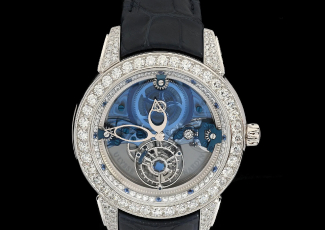Top lot: One of very few known brown-spotted Wilcox Wigglers, graded Near-Excellent with clear solid-glass eyes and beautiful hardware, sold with its equally rare Wiggler Mfg. Co. box for $39,600

DENVER, Pa. – There wasn’t a fishing pole in sight, but it was clear that guests who gathered at Morphy Auctions’ gallery on May 17, 2025 were there to land the catch of the day. It was time for Part II of Wayne and Lori Edens’ acclaimed collection of antique baits to cross the auction block, and no serious collector of fishing paraphernalia was going to miss it. Five months after Morphy’s debut sale of selections from the Florida couple’s extraordinary assemblage of lures (12/9/2024, total $900,000), interest was just as high for the follow-up offering, which rang the register at $863,000.
The top lot of the day was also one of the rarest combos in the Edens collection – a brown-spotted Wilcox Wiggler graded Near-Excellent with clear solid-glass eyes. One of few of its type ever found, it came with an equally rare VG-condition paper label box from The Wiggler Mfg. Co., Elmwood, Indiana, with its extremely rare paper insert still intact inside the lid. Its hardware was noteworthy, as it appeared that it probably had never seen water. The lure claimed a winning bid of $39,600 against a pre-sale estimate of $10,000-$20,000.
Another popular entry was a brown and gold Enterprise Mfg. Co. (Pflueger), Akron, Ohio, Trory Minnow. A very early model dating to 1900 or 1901, at the latest, its details included large, blemish-free glass eyes, a crudely-formed wooden tail, gold perch bars on a natural brown body with dark back, and a silver belly with fine hand-painted gill marks on either side. This lure had been discovered in a tackle box in the Canton, Ohio area and presented in Excellent Minus condition. Against an estimate of $6,000-$12,000, it proved its merit with a $23,400 selling price.
A Heddon Introductory Model 155 all-brass Dowagiac Minnow, graded Excellent with solid yellow paint and black gill marks, featured perfect white iris glass eyes and three belly weights, each completely sealed. All five non-nickel-plated hooks appeared original. It came with a box that was of the correct era for the lure, a type II with thicker panels and a thumbnail notch on lid, bearing the phrase NOTICE HOW THE HOOKS ARE HUNG! Morphy’s specialist who wrote the catalog description for this lure noted that “very few Heddon Minnows combine this magnitude of rarity with such beautiful condition.” It sold above its high estimate for $20,900.
An especially historic entry was and example of the first American wooden minnow characterizing the link between the rotary and cedar plugs of the late 1890s and the first commercially offered minnows from just after the turn of the century. The auction example was the exact bait famously found in Twin Lakes, Ohio, resident Hiram C. Rice’s tackle box. The hand-shaped bait displayed natural wood grain, a dark back, slightly curving gill marks, striking copper-colored ‘perch’ stripes, and a golden belly. Its “File Maker” spade-shaped props were original and identical to those on a similar bait shown in an Arlan Carter reference book. In strong VG Plus condition, it changed hands for $14,100.
An extraordinary 1905 Heddon Hi-Forehead 150 Minnow Combo bait, complete and correct with immaculate glass eyes and solid yellow paint with hand-painted sweeping red gills, was paired with its correct wooden box having end panels correctly stamped YELLOW No 155. Additionally, it still had its correct paper insert advertising a bait known as the “Killer.” Surely one of the highest-grade examples known of a rare bait, it sold for $23,400 against an estimate of $10,000-$20,000.
Rare and attractive, a circa-1903 Rhodes Musky Minnow bait was designed with an aluminum base, green back, and multiple red bill decorations on each side. Retaining all side hooks and pre-patent bowtie tube props, and with small glass bead eyes, the 6½-inch bait was noticeably larger than its 4-inch cousins. It was bid to just below its high estimate, settling at $11,700.
Heddon 1902 Dowagiac Underwater Casting Bait, Type III version, gold-washed nose, brass eyes, tail caps, side cups, and nickel-plated, winged prop. One of very few examples known to exist. Graded Very Good Plus with a box of the correct era marked for a similar Underwater in aluminum. Sold for $11,700 against an estimate of $2,000-$4,000
The earliest iteration of a Heddon 1300 Musky Sucker bait, dating to 1913, showed off its original “Sucker” finish, heavy-duty hardware, perfect glass eyes, a marked front prop, and four belly weights. Its correct factory box bore a label depicting the company’s iconic “Downleaping Bass.” The 5¾-inch bait ending its bidding run at $11,000 against an estimate of $5,000-$10,000.
To discuss consigning vintage fishing lures, sports memorabilia, or any high-quality antique, artwork or collectible to a future auction at Morphy’s, whether a single item or an entire collection, please call Dan Morphy at 877-968-8880 or email [email protected]. Visit Morphy’s online at www.morphyauctions.com.




















